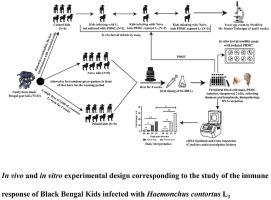黑孟加拉山羊外周血单核细胞驱动细胞因子和转录因子诱导对扭曲血蜱的抗性。
IF 2.4
3区 农林科学
Q1 FISHERIES
引用次数: 0
摘要
弯曲血蜱是小反刍动物健康和生产力的主要威胁。尽管早期Th2细胞因子和转录因子的表达在自然抗性品种中具有保护作用,但黑孟加拉山羊(BBG)抗性的免疫基础仍未被探索。我们比较了早期pbmc介导的细胞因子和转录反应,以及它们在感染的前7天内对幼稚和启动BBG儿童幼虫运动的直接影响。孩子们每周被灌输2000 L3,持续四周,或者不被灌输,然后被灌输10000 L3。每组在每个时间点牺牲2名儿童。在死前采集全血进行鉴别计数和PBMC分离,同时收集皱胃黏膜和引流LN进行组织学和RNA提取。到第7天,启动儿童的皱胃L4负担减少了58%,PCV (p3活力)升高(与未启动PBMCs相比)(p< 0.01),并且用启动PBMCs预处理的L3导致第5周粪便鸡蛋数量减少60% (p< 0.001)。这是首个将每日PBMC转录组学与bbg的功能运动性和感染性分析结合起来的研究。这些发现确定了新的生物标志物,为可持续控制寄生虫的选择性育种和免疫预防策略提供了信息。本文章由计算机程序翻译,如有差异,请以英文原文为准。

Peripheral blood mononuclear cell-driven cytokine and transcription factors induction confers resistance to Haemonchus contortus in Black Bengal goats
Haemonchus contortus is a major threat to small ruminant health and productivity. Although early Th2 cytokine and transcription factor expression confers protection in naturally resistant breeds, the immune basis of resistance in Black Bengal goats (BBG) remains unexplored. We compare early PBMC-mediated cytokine and transcriptional responses and their direct effects on larval motility between naive and primed BBG kids during the first seven days of infection. Kids were primed with 2000 L3 weekly for four weeks or left naive, then challenged with 10,000 L3. Two kids per group were sacrificed on each time point. Whole blood was collected pre-mortem for differential counts and PBMC isolation, while abomasal mucosa and draining LN were harvested for histology and RNA extraction. Primed kids exhibited a 58 % reduction in abomasal L4 burden by day 7, elevated PCV (p < 0.05), and a threefold greater increase in LN weight compared to naive kids. Histopathology revealed significantly enhanced eosinophil and neutrophil infiltration in abomasal mucosa of primed kids. Cytokine and gene expression assay showed early upregulation of Interleukin (IL)-4, IL-5, IL-13, IL-33, MCP-1, CXCL-1, TLR-2, and GAL-14 (p < 0.05). In vitro, co-culture with primed PBMCs reduced L3 motility compared to naive PBMCs (p < 0.01) and L3 pretreated with primed PBMCs resulted in a 60 % reduction in fecal egg counts by week 5 (p < 0.001). This is the first study to integrate daily PBMC transcriptomics with functional motility and infectivity assays in BBGs. The findings identify novel biomarkers, inform selective breeding and immunoprophylactic strategies for sustainable parasite control.
求助全文
通过发布文献求助,成功后即可免费获取论文全文。
去求助
来源期刊
CiteScore
6.20
自引率
6.90%
发文量
206
审稿时长
49 days
期刊介绍:
Developmental and Comparative Immunology (DCI) is an international journal that publishes articles describing original research in all areas of immunology, including comparative aspects of immunity and the evolution and development of the immune system. Manuscripts describing studies of immune systems in both vertebrates and invertebrates are welcome. All levels of immunological investigations are appropriate: organismal, cellular, biochemical and molecular genetics, extending to such fields as aging of the immune system, interaction between the immune and neuroendocrine system and intestinal immunity.

 求助内容:
求助内容: 应助结果提醒方式:
应助结果提醒方式:


